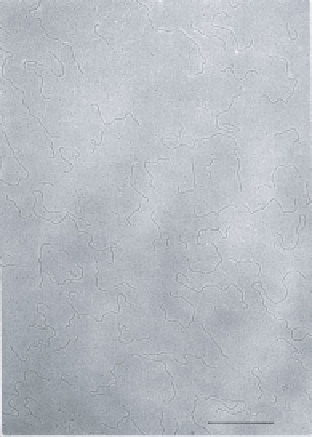Information Technology Reference
In-Depth Information
Figure 9.6
Electron micrograph of
macronuclear DNA molecules from
Sterkiella nova
. Bar
=
1
µ
m. Courtesy
of Dr. K. G. Murti.
DNA that makes up most of the micronuclear DNA. Thus, in the conversion of
a micronucleus to a macronucleus, the genes, representing less than 5% of the
DNA, are excised from the micronuclear DNA, and all the spacer DNA, which
makes up more than 95% of micronuclear DNA, is destroyed.
We can learn a little more about these events by microscopic observation.
During the first 24 h (at 23°C) in the micronucleus-to-macronucleus conver-
sion, polytene chromosomes are formed by 5 rounds, of replication of the DNA
molecule in each chromosome in the diploid micronucleus. First, the two ho-
mologous copies of each chromosome align tightly with each other to form
one composite chromosome. With each round of replication the copy number
of DNA molecules in each of these composite chromosomes doubles. After
five rounds, the resulting 64 identical copies in every composite chromosome
remain aligned tightly in parallel to create a group of giant, or polytene chro-
mosomes, as shown in the electron micrograph in Figure 9.7. Note that the
polytene chromosomes have many cross-striations consisting of dark and light
interbands. Each dark band results from a local condensation by tight coiling of
a segment of each DNA molecule as it traverses the full length of a chromosome;
in interbands the DNA molecules are not condensed, continuing in a straight
form from band to band.
Once the polytene chromosomes are fully formed, they are destroyed in
a very specific way that reflects major processing of the DNA molecules. A
proteinaceous septum forms, cutting across each interband and transecting the
64 DNA molecules (Figure 9.8).

